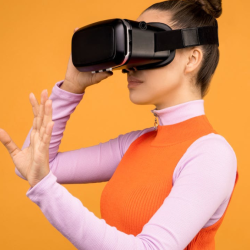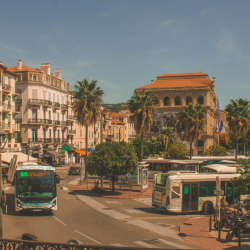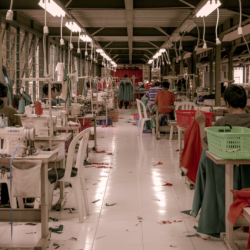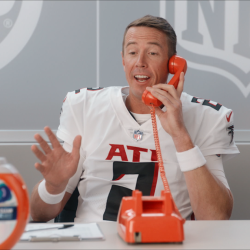In this interview we spoke to isla’s Community and Stakeholder Engagement Manager, Alex Camacho, to find out how to creativity can be elegantly injected into communications to effectively hit more more environmental goals. Note: isla works with agencies, brands, organisers and suppliers to provide guidance and support on environmental issues.
Hi Alex, good to talk. So, first off, in your experience, how exactly does creativity drive sustainability?

You can improve sustainability in your own company’s operations, and you can positively influence this within your supply chain, but events also have the capacity to affect hundreds or thousands of people beyond those directly involved in their delivery.
Events are often creative by their very nature, attempting to engage as best they can a specific audience around a common topic. Even if it doesn’t happen to be the primary theme of the gathering, events also offering the opportunity for formal education in an informal environment. When on-site, the minds of staff and attendees are open to new sights and sounds, new people and ideas. They are the perfect place to engage audiences with sustainability issues and practices, not only regarding the event itself, but calls-to-action around what they can do in their own lives. The more creative the engagement, the more likely the messaging can nudge people forwards from an undecided phase of behavioural change, to another more action-driven stage.
Every brand, event agency, venue or supplier has at least some form of creative design or marketing capability. Leverage the creative resources you already have at your disposal to establish causality between your plans, actions and results; in order to amplify your influence beyond the boundaries of your company. If your creative resources are more limited, remember that each sectors’ particular set of stakeholders can only be as successful in sustainability as the wider supply chains that support them. In which case, ask how you can collaboratively leverage the creative resources of your partners to accelerate the transition to benefit of all.
Will creativity heighten the appeal and awareness of sustainability issues? Will this influence perceptions and behaviours on this topic, do you think?
There’s a significant body of research which suggests that our brains are evolutionarily developed to ignore the climate crisis, insofar as we are hard-wired to contend with immediate, tangible threats as opposed to distant and future outcomes, ones which are more abstract. Furthermore, behavioural science has taught us that people respond much better to positives than they do to negatives. This goes some way towards explaining why hitting the average person over the head with climate science (and the dire consequences of inaction) doesn’t necessarily turn the dial forwards as much as we’d like it to.
It takes creativity to understand the needs, motivations and communication styles of the different stakeholders involved, and creativity requires exercising a certain emotional intelligence and empathy. At isla we encourage our members to enact this creativity through ‘selling the sizzle not the sausage’, in order to increase buy-in from stakeholders (who may be reluctant for a multitude of reasons). The ‘sizzle’ is the tangible benefits of implementing sustainable measures, rather than the processes that necessarily sit behind that. The better you know your audiences, from clients to suppliers to attendees, the better you’ll be able to put forward the ‘sizzles’ which appeal to them. In a sustainability sense, yes, we want to reduce our emissions and our waste volumes: this data can be calculated and demonstrated. But how can we creatively communicate other (potentially more appealing) benefits to stakeholders less interested in those metrics for now?
Looking at corporate event clients or sponsors, usually with considerable pools of creative resource themselves, there can often be a big disconnect between what a particular brand is publicly stating in their CSR or ESG policy, and how this manifests as part of the event planning and delivery. Some of the most progressive corporations in terms of sustainability still relegate their own event sustainability to an afterthought. For these stakeholders, this might mean taking apart their sustainability comms and reports in order to develop proposals which could creatively activate an area of their own policies and ambitions as a physical and/or educational element of the event you’re organising for them. For an attendee, this could mean the creative deployment of choice architecture and playing with individuals’ ‘effort vs benefit perception’ — making the most sustainable choices during their visit also the default, cheapest or easiest choice for them to make — thus helping to normalise them.
I can’t profess to have the very specific experience and expertise of a renowned caterer, a long-established AV supplier or the CEO of a major conference centre, but what I can do is put myself in theirs shoes as much as I can, to better understand their own challenges and priorities. I’ve found the most positive responses I’ve had to my client work have been when I’ve employed a little imagination in the examples I use or the exercises I set — when I’ve helped them to understand which sizzles appeal to both them and their partners. At the same time, don’t be disheartened if your creative comms don’t hit the right notes for everyone. What motivates one team or individual might demotivate another. It’s an ongoing learning process which does require a hint of trial and error to find the sweet spot.
How can we practically integrate creativity into sharing sustainability messaging?
Communications can often be the missing link determining whether even the best laid sustainability plans are as actioned or influential as you intended them to be. When dealing with such complex and intersectional matters as climate science, ethics, innovation, policy and economics, combined with dense data collection and analysis, you have to remember that these topics might not be of as much immediate interest or perceived relevance to everyone. With this in mind, there can be a risk that the essential information that you are trying to convey may come across as slightly dry, or even sanctimonious to certain audiences. In which case, think about the messengers of your words. Who are the faces or avatars of your messaging? Do they appeal to or resonate with the audience you’re trying to reach? Are they striking the right tone? Above I mentioned the sizzle, the tangible benefits, but sometimes it also takes some creative storytelling before you even get to that stage. How can you creatively frame complex subjects in a compelling, credible and easy-to-understand manner in the moment?
Likewise, never underestimate the power of a good visual. Presenting your data through Infographics that make the point you want to make at a glance will have infinitely more impact than a spreadsheet. Creative visuals can of course be used to convey ideas as well as data. For example, the United Nations Sustainable Development Goals, which serve as an attempt to distil the entirety of the world’s social and environmental issues into an exhaustive collection of interdependent classifications. By removing the barriers of scientific or political jargon, these 17 coloured icons have become widely known and readily understood around the world — the designers focusing on a promotion of simplicity, without losing the original meaning.
Finally, ask yourself, how, and to what extent, are you listening and responding to your audiences? What does this say about your willingness to change? This communication needs to be a two-way street — establishing a dialogue with your audiences. This is about communicating in a partnership, not at them — providing opportunities for the audience to change the subject or priorities of the conversation and genuinely considering their ideas. Strengthening these relationships requires continuous creative engagement and builds further trust.
Featured image: Ricardo Gomez Angel / Unsplash


































